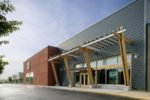Owners Beware: Building Modifications Can Void a Component’s Fire Rating
Building owners usually enhance or maintain their property investments through renovations and modifications. While these can help add value and functionality to a structure, alterations, and changes may compromise the fire-resistance properties of fire-rated assemblies.
Changes like drilling in walls or replacing fire-rated doors with non-rated alternatives can disrupt carefully engineered fire-rated assemblies. The consequences of these alterations include a violation of the building and fire safety code.
Breaching fire-rated walls to install fire alarm cables and replacing them with non-rated suspended ceiling tiles can void the assembly’s fire rating. This permits the spread of fire through the roof space and creates inadequate compartmentalization.
Structural changes like removing or altering fire-rated walls can also compromise the fire safety of a property. Openings created in fire-rated walls and ceilings without proper repair and sealing enable fire and smoke to spread rapidly.
Replacing fire-rated doors and windows with non-rated alternatives reduces the effectiveness of a building’s fire prevention system. Changing the door frame, door hardware, and threshold can affect the door’s fire rating as it is a complete assembly.
When making any modifications, property owners and managers must recognize the importance of fire safety. They should identify the location of fire-rated components to know which areas cannot be changed without affecting fire safety. They can pinpoint fire-rated assemblies in a property with the assistance of a building inspection engineer NJ.
Engineers can also be consulted regarding modifications involving penetrations, as these actions may leave unseen holes in fire-rated components. Owners can leverage the expertise of a professional NJ structural engineer to execute projects that do not adversely affect the fire rating of assemblies. Their involvement in the process helps maintain the safety and integrity of a building, which protects both occupants and the property.
Professionals can also coordinate with local building and fire safety authorities to maintain compliance with the required fire protection standards. They can provide the required documentation and technical details that demonstrate code compliance.
For more details about how building modifications can compromise a component’s fire rating, here is an infographic by Lockatong Engineering.







